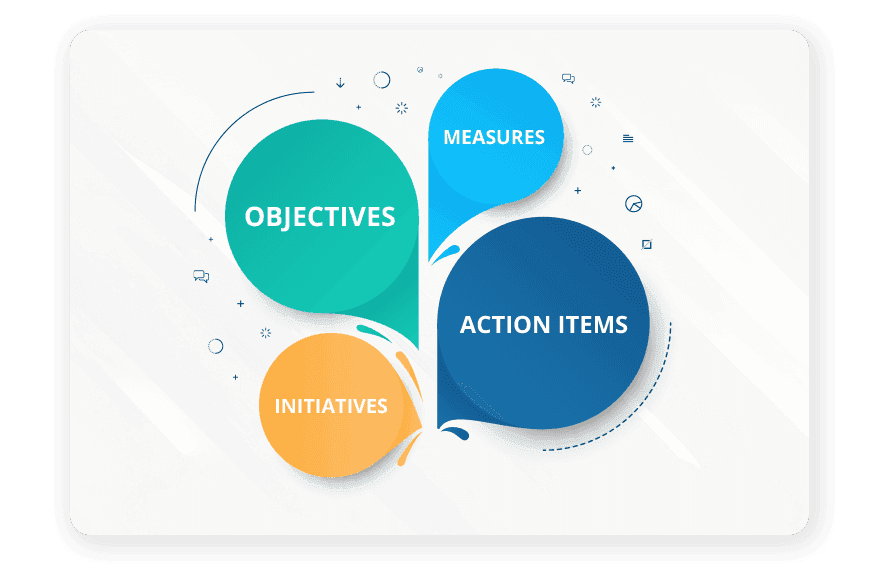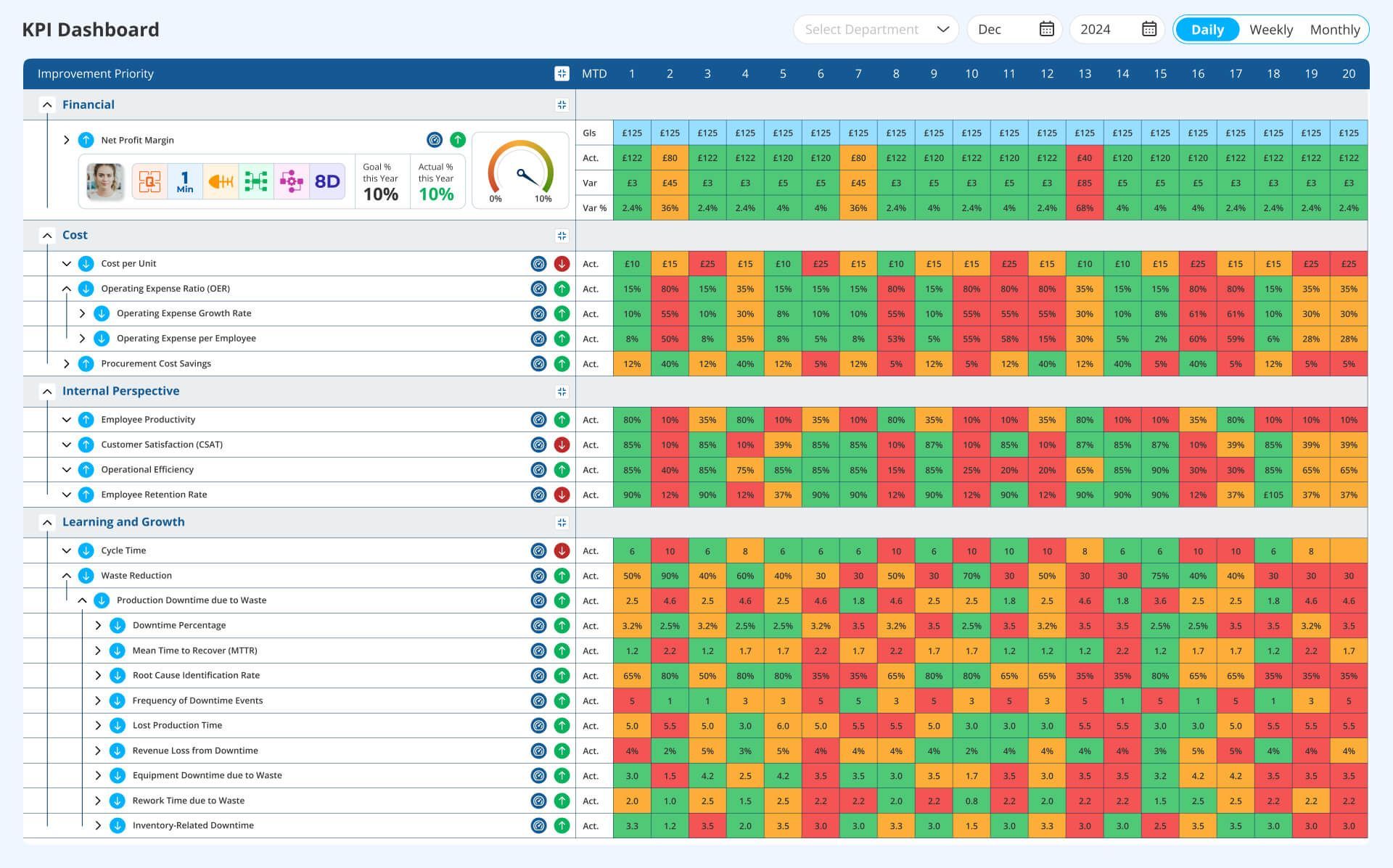
A Balanced Scorecard (BSC) can be defined as a strategic management tool, or a well-structured reporting framework designed to help organisations track, measure, and manage performance in line with their goals.
In simple terms, the Balanced Scorecard turns strategy into clear targets, real-time reporting, and practical actions. Want to know how? - It doesn’t just help formulate an organisational strategy – it helps put it into practice and track its impact in a single framework. So, it can be said that BSC acts as practical guiding system for decision making, problem solving and achieving organisational goals.
Its two simple dimensions include:
- Balancing: The key perspectives in an organisation: customers, internal processes, learning and growth, and finance. These areas are connected; progress in one support progress in the others.
- Scoring: Choosing a small number of clear, practical performance measures (KPIs) that show whether each perspective is delivering what the strategy needs.
Trusted by thousands of organisations worldwide from global brands like Apple and Volkswagen to small businesses and government agencies, the Balanced Scorecard remains one of the most widely used frameworks for aligning teams with strategy and performance.
Balanced Scorecard: How an idea evolved into a digital strategy tool for leaders
It’s been 33 years since the Balanced Scorecard was first developed by Dr. Robert Kaplan, a Harvard Business School professor, and Dr. David Norton, a renowned management consultant. In 1992, they published their ground-breaking article, The Balanced Scorecard—Measures That Drive Performance, in Harvard Business Review, introducing the idea of combining financial and non-financial measures in a single framework.
Back then, most organisations relied heavily on financial results alone for judging performance and making management decisions. Kaplan and Norton’s work added non-financial measures. Unlike a single financial report, the Balanced Scorecard connects strategy with action by combining financial data with non-financial indicators — such as customer satisfaction, internal processes, and learning and growth; which is known as the four perspectives of Balanced Scorecard. Kaplan and Norton used the term “Scorecard” (comes directly from the idea of keeping scores like in sports) intentionally, because they wanted managers to have a clear, at-a-glance view of whether the company was “winning” or “losing” against its strategic goals.
The Balanced Scorecard quickly gained recognition as one of the most significant management ideas of the past 75 years, according to the Harvard Business Review.
From book to boardroom: How BSC expanded to fit real organisations
What began as a simple measurement tool quickly grew into a practical framework for managing strategy. Kaplan and Norton expanded their ideas through several influential books:
- The Balanced Scorecard: Translating Strategy into Action
Why the smartest companies use a Balanced Scorecard to align and win
If a business asks, “Why should I use a Balanced Scorecard?”, the answer is simple: to connect strategy with real, day-to-day results. how does it drive business improvement?
Over the last years, Balanced Scorecard has grown far beyond its original role as a measurement tool. Today, it serves as a practical framework with two key areas of focus: Strategic implementation management and Operational management.
This clear split is why companies, from global brands to thousands of smaller organisations — still trust the Balanced Scorecard. It doesn’t stop at reporting; it keeps the whole organisation moving in the same direction, with real numbers to prove progress.
From the original four perspectives to strategy maps, visual cause-and-effect links, and modern tools that connect strategy with operations, the Balanced Scorecard’s wide scope makes it more than just a framework, it’s a proven way to keep strategy alive in daily work.
Benefits of using Balanced Scorecard for modern organisations
- Turn strategy into clear goals you can measure Break big ideas into specific objectives and KPIs that everyone can follow.
- See a complete or holistic view of organisational performance Combine financial and non-financial measures in one place for better insights.
- Align teams around shared priorities or operations Keep every department working towards the same clear goals.
- Connect high-level strategy to daily work through clear structure Make sure day-to-day tasks link directly back to the bigger plan.
- Track progress with real-time performance data Monitor results at every level, so issues are visible before they grow.
- Support confident, data-driven decisions Use balanced measures to guide better decisions, not just gut feelings.
- Encourage continuous improvement and learning Spot gaps, learn from results, and adjust strategies over time.
- Manage change and transformation effectively Roll out new goals step by step without losing focus or momentum.
- Increase accountability across teams Assign clear owners for goals, so everyone knows who is responsible.
- Build trust with transparent reporting Share clear performance updates that build confidence inside and outside the organisation.
The Four Balanced Scorecard perspectives
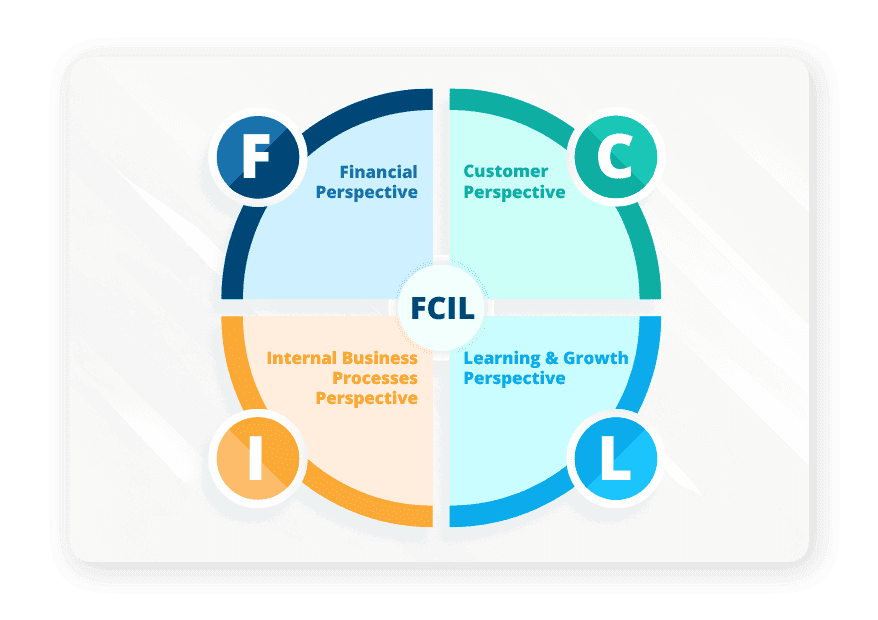
The four perspectives are at the heart of the balanced scorecard; they help organisations see performance from every angle, not just through financial results. This simple structure makes sure that strategy turns into action across all parts of the business.
Read more about the Four perspectives of Balanced Scorecard
How the Balanced Scorecard drives strategic alignment?
Balanced Scorecard as a strategy planning and management tool connects high-level vision to daily actions and clear accountability. Here’s how that strategic alignment happens
Balanced Scorecard alignment flow
Vision and mission → Actionable goals → Team alignment → Accountability and ownership
How the strategic alignment flow works:
- Translating vision and mission into goals: Leaders use the balanced scorecard to turn broad strategy into specific objectives that can be measured.
- Top-down and cross-functional alignment: These goals are shared across departments and levels, so everyone understands how their work supports the wider strategy.
- Accountability and ownership: Clear measures and named owners make sure each goal is tracked — teams know who is responsible and can adjust if results fall behind.
How to develop a Balanced Scorecard: Your proven step-by-step roadmap
Here’s the flow of Balanced Scorecard creation best practices to help you design, build and implement a strategic performance management system that works.
Leadership sets vision and strategy
Senior leaders define the mission, vision and high-level business strategy — often during annual or multi-year planning.
Break strategy into clear objectives
Within the balanced scorecard framework, break the vision down into strategic goals, grouped under the four perspectives. It is recommended to create strategy maps for this.
Create measures (KPIs) and targets
For each goal, clear measures and targets are set. So, teams know what success looks like.
Cascade goals across teams
Objectives are broken down and shared with departments and teams, so every level knows what they are responsible for.
Assign ownership and accountability
Each measure or target has an owner. So, there is clear responsibility for delivering results.
Monitor performance and share feedback
Teams and managers track progress regularly, discuss results, and adjust actions if needed — all inside the balanced scorecard system.
Review and improve
Results feedback to leadership to shape the next round of planning. So, the strategy stays alive, not stuck in a file.
Balanced Scorecard strategy maps: Why visualising objectives inevitable for modern leaders
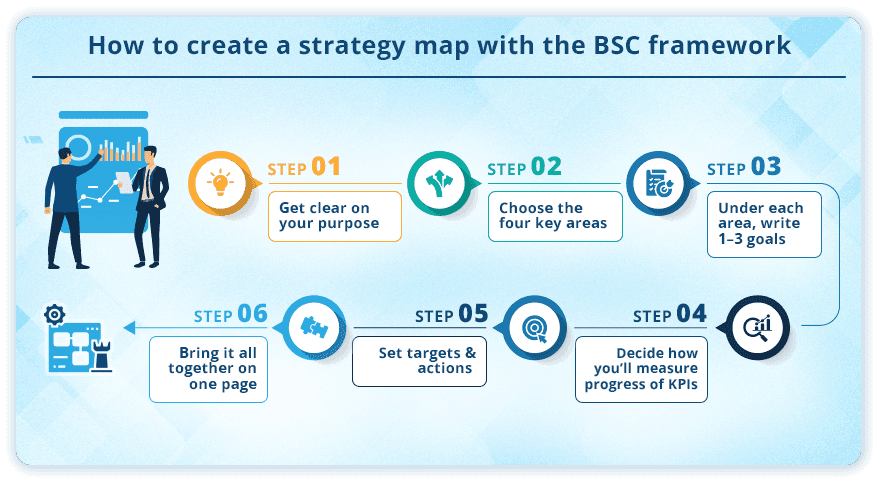
A strategy map is not the balanced scorecard itself — but it is a powerful tool that works alongside it. While the balanced scorecard tracks and measures performance, a strategy map lays out the business logic behind the plan in one clear diagram.
What is a strategy map?
Simply, the strategy map makes the big picture visible on one page. So, teams see exactly how daily actions drive strategic outcomes.
So, a strategy map can be defined as a fundamental business plan that sets out logic by showing what it means for people inside and outside the organisation, highlighting the skills and capabilities needed, and identifying the resources to invest.
But how is a strategy map connected to Balanced Scorecard and how strategy map is different from Balanced Scorecard?
The answer is- A strategy map shows the plan visually; the Balanced Scorecard tracks whether that plan is working.
Hence it can be said that the strategy map within a BSC complements it by showing how an organisation’s vision and strategy break down into key objectives and how these connect across the four balanced scorecard perspectives: financial, customer, internal processes, and learning and growth.
How to build a strategy map that actually works: Guide from design to execution
Clarify your vision and mission
Start with a clear statement of your vision, mission and 2–5 big strategic themes (like growth, innovation, cost control).
Define your main strategic goals
Break the vision down into clear goals across the four balanced scorecard perspectives: financial, customer, internal processes, and learning and growth.
Group goals into cause-and-effect chains
Show how one goal leads to another. For example, better staff skills (learning) improve processes, which raise customer satisfaction and grow revenue.
Draw the map as a clear diagram
Place goals under the four perspectives, connect them with arrows, and keep the layout clean; top is financial, bottom is learning.
Identify critical enablers
Pinpoint what resources, capabilities or partnerships you need. Note these near relevant objectives.
Add clear owners
Assign a department or role to each objective so it’s clear who will drive progress.
Draft it visually
Lay it out on one page:
- Top layer = financial goals Middle = customer and processes Base = learning and growth
- Keep it simple: objectives as boxes, arrows for connections.
Link to your balanced scorecard
Turn each objective into balanced scorecard items: add KPIs, set targets, agree how and when you’ll measure progress.
Review and refine
Test the full map with leaders and teams. Adjust links, priorities or objectives if something doesn’t add up.
Implementing the Balanced Scorecard in your organisation
As a perfect corporate strategy tool, Balanced scorecard practically links what top management wants to achieve and what people do every day.
In simple terms, the Balanced Scorecard connects senior leaders’ judgement about strategic goals, priorities and core competencies with the actions and decisions taken by employees at every level. This clear line of sight alignement ensures that everyone from top-level managers to frontline teams works towards the same objectives.
Now you know how to build your Balanced Scorecard and strategy map. Next, learn how to implement them practically across your organisation.
Who is responsible for leading the Balanced Scorecard in an organisation?
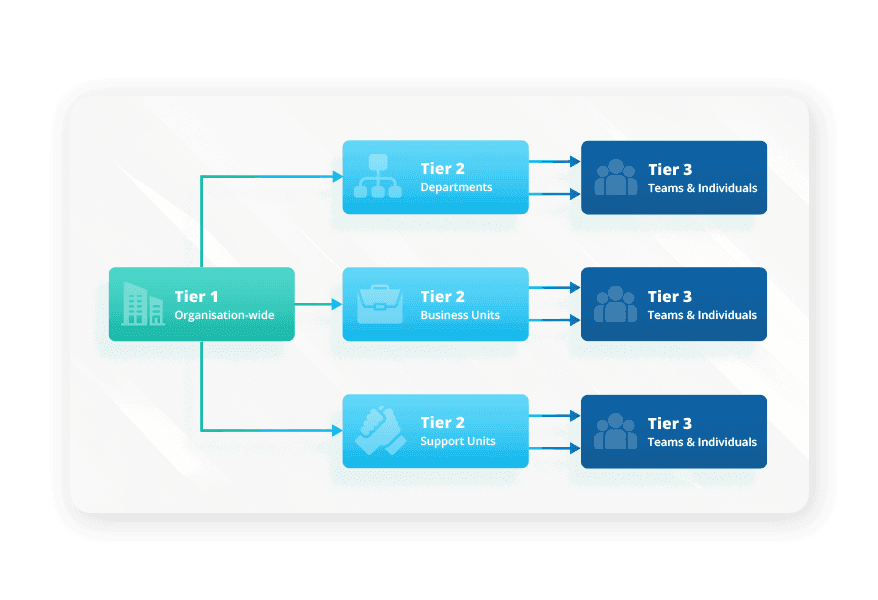
For a Balanced Scorecard to work, Tier 1 leaders and top decision-makers must lead from the front. Tier 2 leaders (like department heads) turn strategy into actionable plans for their teams. Tier 3 (like supervisors and team leads) execute tasks, track metrics, and report progress. Once leadership sets the vision, the right people at every level help put the plan into action and keep it moving. Here’s how the roles usually break down:
Balanced Scorecard and Corporate Governance: Why every organisation needs
Corporate governance refers to the systems, processes, and practices through which organisations are directed and controlled. As BSC helps leaders to align strategic objectives with measurable result, stands out as a governance tool.
How does BSC enhance board reporting? The reason why it is gaining importance in modern Boardrooms
Board reporting means giving the Board of Directors (BoD) clear updates on whether the organisation is achieving its strategy, staying compliant, and using resources well.
The Balanced Scorecard improves this process by:
- Bringing strategy and operations together in one view
- Tracking financial and non-financial measures equally
- Showing progress visually for faster understanding
- Making it easier for boards to hold leaders accountable for results
Common barriers while implementing an organisational Balanced Scorecard and how to overcome them
Lack of clear strategy
- Barrier: If your vision and objectives are vague, your KPIs and actions will be too.
- How to fix: Start with a clear strategy map. Define three to five strategic themes, break them into measurable goals, then build your scorecard around them.
Weak leadership action
- Barrier: Without visible support from senior leaders, teams may see the Balanced Scorecard as just another report.
- How to fix: Involve leaders early. Show how the scorecard links to real priorities. Share results in leadership meetings to keep it alive.
Choosing too many complex KPIs
- Barrier: Overloading teams with too many or overly complicated KPIs confuse people and wastes time.
- How to fix: Keep it simple. Limit each perspective to three to five practical KPIs with clear owners.
Silo thinking between departments
- Barrier: Teams often focus only on their own targets, missing the wider picture.
- How to fix: Use cross-functional workshops when creating the scorecard. Make links between teams clear in the strategy map.
No regular review and update
- Barrier: A scorecard built once and then ignored quickly loses its value.
- How to fix: Review KPIs and results every quarter. Adjust targets and actions if strategy or market conditions change.
Lack of staff understanding or training
- Barrier: If people do not understand how to use the Balanced Scorecard, they will not act on it.
- How to fix: Provide simple training for managers and teams. Explain what the scorecard is for, how to use it and how it helps their work.
Poor data quality or access
How does BSC improve transparency and regulatory compliance?
Transparency is central to good governance. The Balanced Scorecard supports this by clearly mapping who owns which metrics, how they’re measured, and how they tie into strategic goals.
It also embeds compliance-related KPIs (like safety incidents, ESG metrics, or audit findings) into routine performance reviews - turning governance from a static checklist into an active monitoring system.
Example: A BSC with built-in compliance metrics ensures the board can track sustainability targets or safety obligations without relying on separate, siloed reports.
Balanced Scorecard vs traditional methods: Why modern strategists have moved on to BSC
Performance management means setting clear goals, tracking progress, and helping people and teams deliver results that matter. Organisations have used many tools over time to do this from simple goal setting to live dashboards and more structured frameworks.
Common performance management approaches
Before the Balanced Scorecard, companies often relied on standalone measures or tools. Here’s how some popular approaches work:
- KPIs-only approach: Focuses purely on key metrics like revenue or output. Good for tracking results but doesn’t always show how to improve or align work to strategy.
- MBO (Management by Objectives): Teams and managers set targets together. Useful for clear goal-setting but can get stuck at department level without connecting to wider strategy.
- Dashboards: Visual tools showing real-time performance data — good for daily tracking but often lack context for long-term strategy.
- OKRs (Objectives and Key Results): Popular in tech and startups. OKRs set ambitious goals with measurable results but can be hard to tie back to balanced, cross-functional performance if used alone.
A quick comparison: Balanced Scorecard vs other approaches
When to use the Balanced Scorecard?
If you need more than just numbers or dashboards and if you want to connect strategy, people and daily actions in one clear system, then the Balanced Scorecard is the smarter choice.
Also, today’s modern Balanced Scorecard software does even more: it combines dashboards, MBO-style goal setting, live KPI tracking and clear strategy maps, giving you everything you need to manage performance in one place.
Technology’s role in powering intelligent, real-time Balanced Scorecards
Originally, the Balanced Scorecard was a static paper or spreadsheet report. Today, technology has transformed it into an interactive digital system that tracks performance in real time. Modern organisations now use digital Balanced Scorecard or Balanced Scorecard software to connect strategy with daily operations, automate data collection, share live dashboards and ensure teams see the latest performance results instantly. This shift from static reports to dynamic, cloud-based tools means leaders can make faster decisions.
Digital Balanced Scorecard and traditional Balanced Scorecard; Which is better?
⬩ Software vs spreadsheets: why software wins for BSC
While spreadsheets are familiar and low-cost, they fall short in scalability, security, and data accuracy. Manual updates lead to errors, version control issues, and delayed insights.
Balanced Scorecard software, on the other hand, automates data updates, enforces structure, and provides interactive dashboards — saving time while improving reliability. It also supports visual strategy maps, KPI ownership tracking, and performance alerts, making execution more disciplined and transparent.
⬩ Cloud-based vs on-premise tools: Which is better for BSC?
Cloud-based Balanced Scorecard tools offer easier deployment, real-time access across devices, and seamless updates which is ideal for remote teams or multi-site organisations. They also support role-based access, enhancing governance and collaboration.
On-premise tools may suit organisations with strict data control needs but often involve higher upfront costs and limited scalability.
⬩ Why integrations matter: Connecting ERP, CRM, and BI with the Balanced Scorecard
A Balanced Scorecard becomes far more powerful when integrated with existing systems like ERP (Enterprise Resource Planning), CRM (Customer Relationship Management), and BI (Business Intelligence) platforms.
These integrations pull live data directly into KPIs that eliminate duplication, reduce latency, and ensure that performance metrics reflect real-time business activity.
Example: A manufacturing firm can link ERP data on production downtime or delivery lead times straight into its BSC, giving leaders instant visibility into bottlenecks.
Takeaway: Integration turns the BSC into a real-time control tower for strategy execution — not just a reporting tool.
Balanced Scorecard and digital transformation: Reimagining the Balanced Scorecard for the modern enterprise
Digital transformation isn’t just about adopting new technologies; it’s about reshaping how organisations think, decide, and perform. The Balanced Scorecard provides the strategic structure to guide this shift. It connects evolving digital initiatives with clear business outcomes, enabling leaders to manage transformation with focus and accountability.
⬩ How BSC aligns with agile business models?
The Balanced Scorecard aligns strategy with agile execution by making goals visible, measurable, and adaptable.
Agile organisations thrive on flexibility, fast feedback, and continuous improvement. The Balanced Scorecard supports this by breaking long-term strategies into short, trackable objectives across key perspectives like process efficiency, innovation, and customer value.
In agile teams, KPIs can be reviewed in sprints, tied to OKRs (Objectives and Key Results), or visualised in digital Obeya boards which allowing real-time tracking and rapid course correction.
How does the BSC support data-driven decision-making?
The Balanced Scorecard turns raw data into actionable insights. By integrating with live data sources like BI tools, ERP, and operational dashboards it translates metrics into clear, strategic signals for leadership.
Key value: It doesn’t just show what happened, but whether current performance aligns with the strategy that helping leaders focus on what truly drives outcomes, not just operational noise.
ESG standards are evolving - What’s the role of BSC in ESG and sustainability reporting?
ESG stands for Environmental, Social and Governance. It’s a broad framework companies use to show how responsibly they manage their impact on the world and on people. But ESG goals often fail due to lack of integration with day-to-day operations. The Balanced Scorecard bridges this gap by embedding environmental, social, and governance metrics directly into strategic planning and review cycles.
Example: Companies use BSC to track carbon emissions per product unit, supplier ethics compliance, DEI targets, or waste reduction KPIs with a Balanced Scorecard alongside core business metrics.
Why it works: The BSC gives ESG efforts structure, ownership, and visibility which transforms them from standalone reports into drivers of long-term value.
Balanced Scorecard for C-level executives: What every leader should know
The Balanced Scorecard helps executives see if their strategy is working and where to pivot.
For example:
- CEOs gain clarity on whether strategic priorities are driving outcomes.
- CFOs see how financial metrics align with process and investment returns.
- COOs track efficiencies and bottlenecks across value streams.
- CIOs monitor digital KPIs tied to innovation, security, and system adoption.
⬩ How BSC supports visionary and accountable leadership goals?
C-level goals often span multiple time horizons including growth, efficiency, innovation, and risk. The BSC allows executives to cascade these into balanced KPIs that departments can act on
It supports:
- Clarity: Clear visibility on strategic drivers across functions.
- Alignment: Keeps all departments moving toward the same objectives.
- Focus: Filters out distractions by tying projects to core goals.
⬩ How can leaders use the Balanced Scorecard to ensure accountability and ROI?
The BSC embeds ownership at every level, linking KPIs to accountable individuals or teams. This ensures that strategic initiatives don’t just start; they finish, with measurable impact.
For ROI, the BSC helps track:
- Strategic project delivery vs budget
- KPI trends over time
- Investment outcomes in areas like digital transformation or sustainability
Example: A CIO can track the ROI of a cloud migration not just through cost savings, but through improved uptime, speed, and innovation metrics - all reflected in the BSC.
Balanced Scorecard and performance reviews
Individual growth and business growth – the two contributions of BSC can be attained through the fairness of performance reviews it powers by linking individual performance with organisational strategy.
⬩ How does the Balanced Scorecard link to employee performance management?
The BSC connects each employee’s work to broader organisational goals by cascading strategic objectives down to team and individual KPIs. This ensures that everyone knows how their role contributes to success.
Benefits of BSC in performance management:
- Clarity: Employees understand what is expected and why it matters.
- Alignment: Individual goals tie directly to department and company-level KPIs.
- Fairness: Evaluations are based on measurable outcomes, not subjective opinions.
- Consistency: Standardised scorecards ensure uniform performance tracking.
⬩ How does the Balanced Scorecard support goal setting, reviews, and rewards?
By using BSC principles, organisations can set SMART goals under key perspectives such as customer satisfaction, process efficiency, learning and growth, and financial contribution. Performance reviews then assess actual contributions to these strategic objectives.
A sample structure of BSC from goal setting to reward:
- Set goals under relevant BSC perspectives (e.g. reduce customer churn by 5%, complete training on digital tools).
- Track progress through live dashboards or periodic check-ins.
- Review outcomes based on both leading and lagging KPIs.
- Link rewards (bonuses, recognition, promotions) to goal achievement and contribution to strategy.
Balanced Scorecard for resource allocation and budgeting
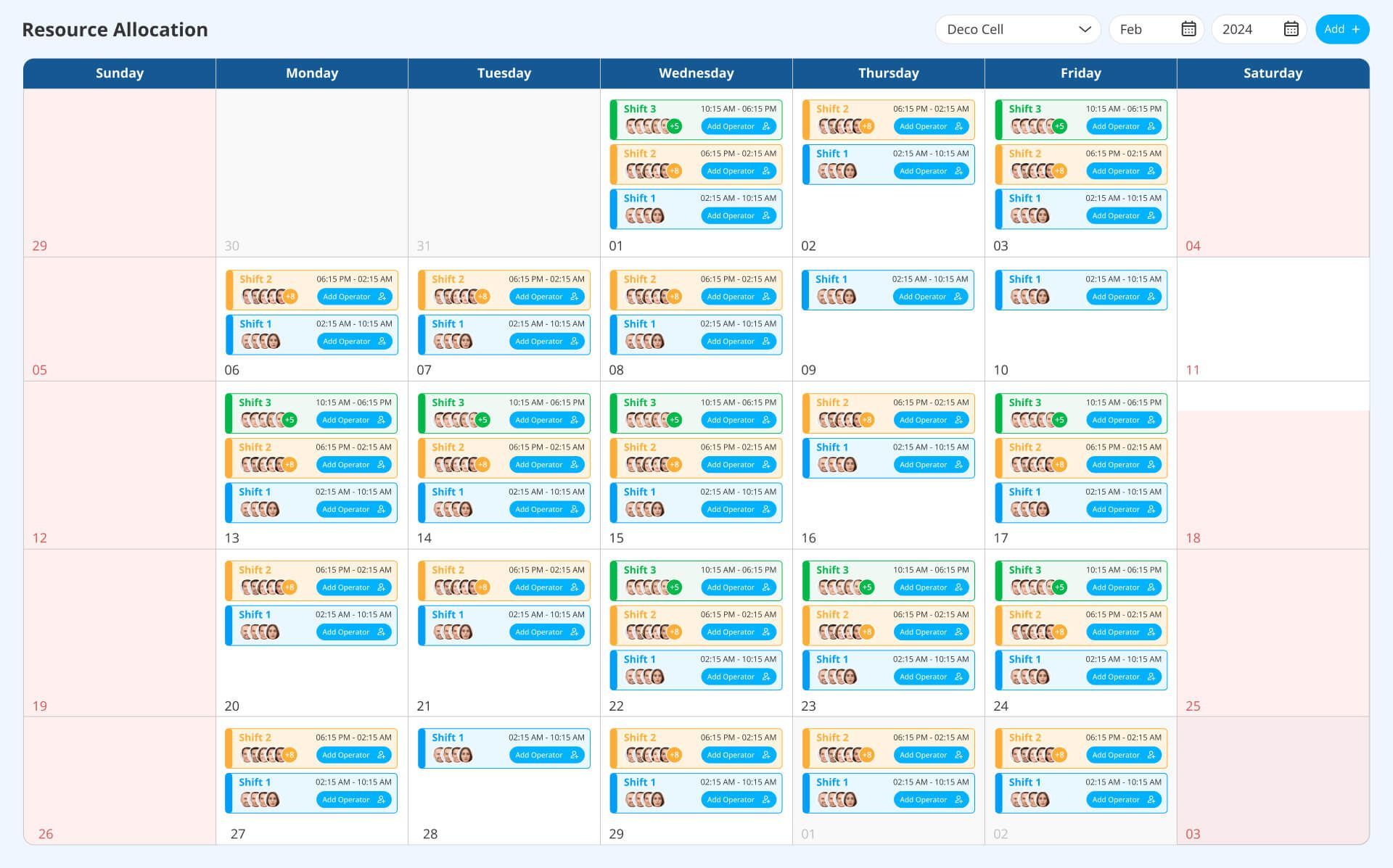
Strategic plans often fail not because the ideas are flawed but because execution breaks down. Rather than treating the strategic plan as a static document, the BSC turns it into a living framework that connects goals to resource allocation and budgeting.
Strategic plans are only effective when supported by the right resources. The BSC enables leadership teams to prioritise funding, time, and talent based on what truly drives strategy.
Here’s how BSC supports smarter resource allocation:
- Links budget requests directly to strategic objectives
- Identifies underperforming or misaligned initiatives early
- Helps prevent overinvestment in low-impact areas
- Enables evidence-based trade-offs between competing priorities
Example: If a goal is to improve customer retention, the BSC may highlight a need to allocate more budget toward CRM tools, frontline training, or user experience — rather than new customer acquisition.
Real-world Balanced Scorecard example or success story
How PCI Pharma streamlined their continuous improvement with Data Point Balanced Scorecard
Balanced Scorecard frameworks show their true value through real-world success. Here’s how a global pharma giant, PCI Pharma Services, turned strategy into clear, measurable progress with a digital Balanced Scorecard.
Who are they?
PCI Pharma is a leading global CDMO supporting the world’s top pharma and biotech companies. PCI Pharma Services' Bridgend facility in the UK is a top-notch provider of Pharmaceutical development services. With clients in over 100 countries, Bridgend offers comprehensive support throughout the product life cycle, from early development to commercial launch and long-term supply.
Balanced Scorecard in 2025: Why it wins in the era of AI, ESG, and real-time strategy
In an age of rapid change, shifting markets and constant disruption, many performance frameworks come and go but the Balanced Scorecard remains relevant because it adapts.
Today’s best organisations use it not as a static score sheet but as a living management system. Modern Balanced Scorecards connect real-time data, AI insights and dynamic dashboards to help leaders steer strategy and day-to-day operations in sync.
By blending financial and non-financial measures, it closes the gap between big-picture vision and front-line actions. It gives teams clear priorities, owners and feedback loops essential for staying competitive, proving ESG reporting and commitments, and driving continuous improvement in an unpredictable world.
That’s why the Balanced Scorecard still matters: it evolves with technology, fits hybrid work and complex supply chains, and keeps everyone aligned around what success really looks like today and tomorrow.
Data Point Balanced Scorecard: Best software for strategic planning to execution
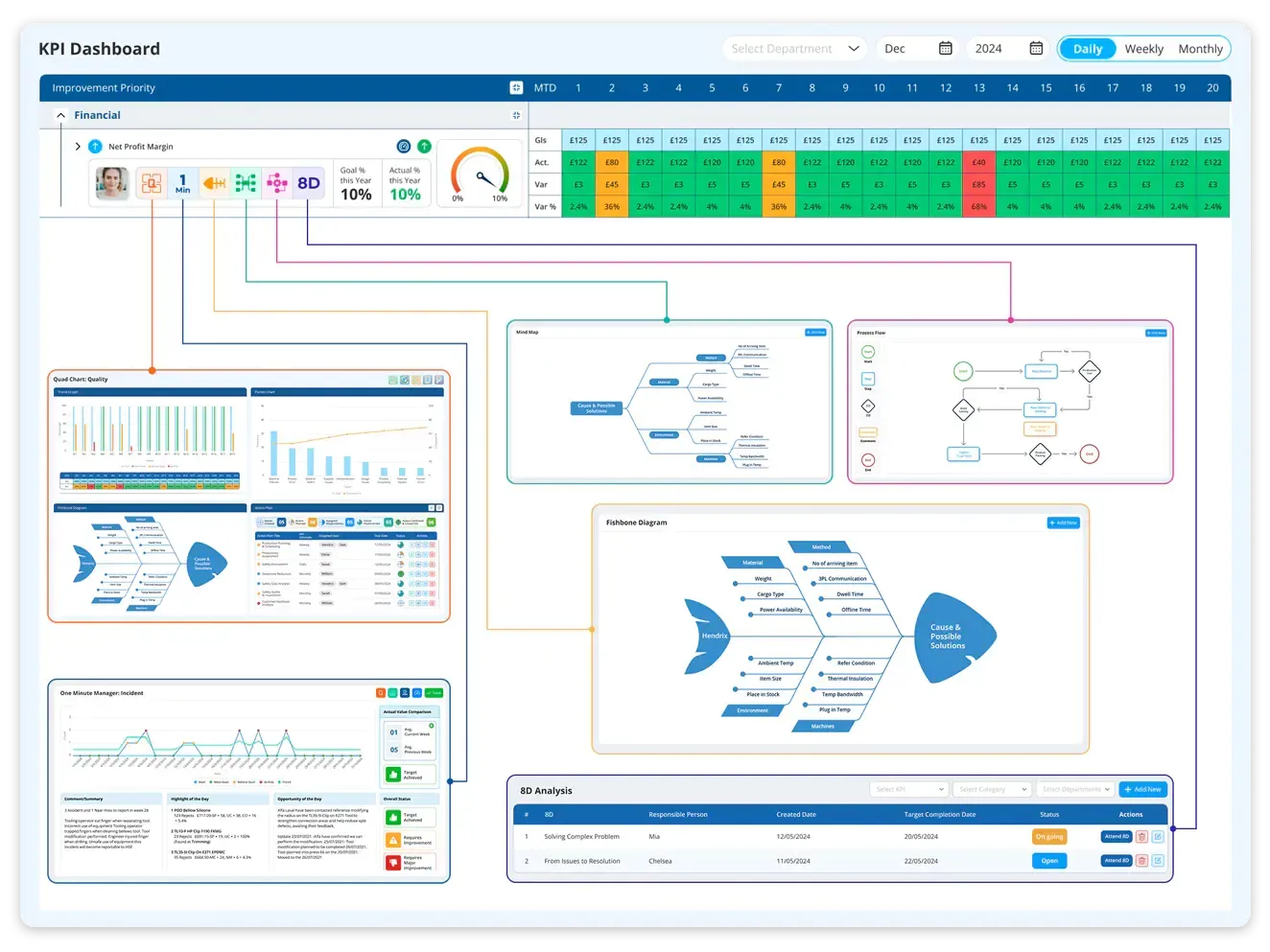
Data Point delivers a modern, cloud-enabled Digital Balanced Scorecard platform tailored for operational excellence and strategic clarity. From real-time KPI dashboards and seamless ERP/MES integrations to mobility and enterprise-grade security, Data Point equips leaders with actionable insights across the organisation by act as lean daily management system.
Its support for frameworks like Hoshin Kanri X-matrix (for strategy planning), Fishbone diagrams
